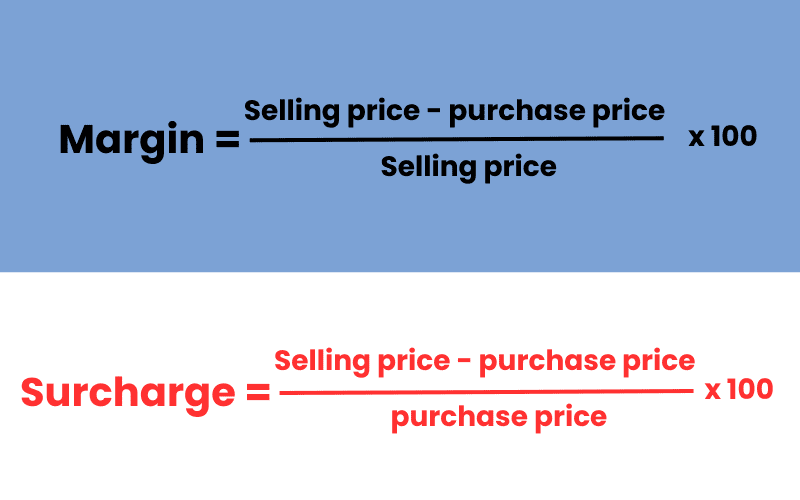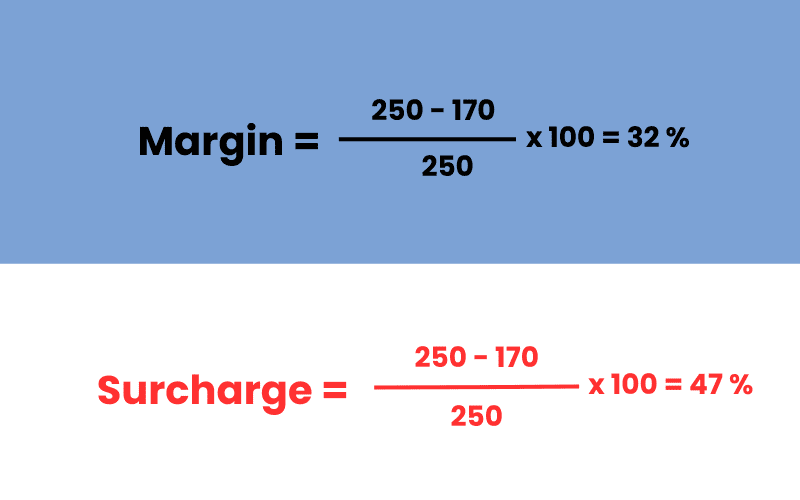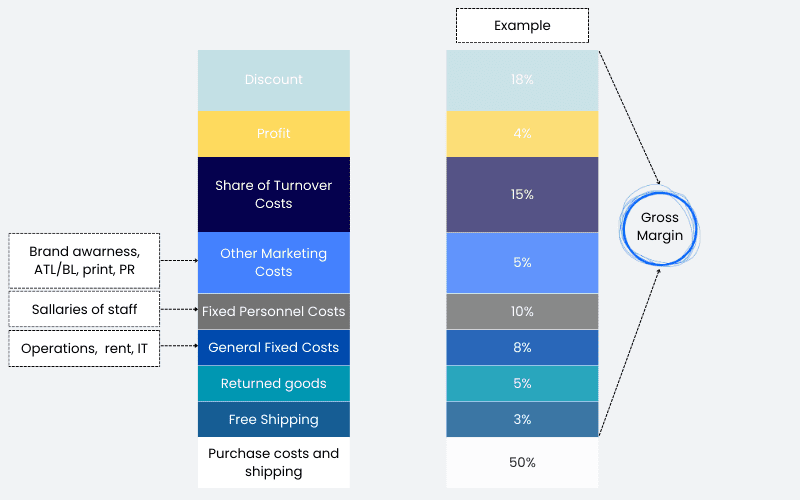We’ve had hundreds of online stores pass through our hands, and we often find that many e-retailers are unaware of the difference between sales and profit.
They are mistakenly pushing money into marketing and continually entering new markets, ignoring one of the most important metrics – margin.
You have a problem if you don’t understand margin and all the things that feed off it. To manage the business, you must know how gross and net margins behave and how margins vary across categories and countries.
In e-commerce, it’s simple. If you aren’t measuring something, you’ve not got it under control.
What is profit margin
In simple terms, the margin signifies the difference between the sale and purchase prices. It’s the gross profit you make from selling products or services. It tells you what percentage of the sales price (excluding VAT) you have left over to run your business with.
What’s considered a healthy profit margin?
Margin is a financial indicator of a company’s profitability and financial health. It accurately delineates a company’s profit margin.
This space is different for every online store. In some places, it is 25%. In others, it can be as much as 60%. In manufacturing companies, it is around 40 to 60%. In services, it can even reach 70%.
The larger this space is, the better you can optimise processes and increase net profit. Margins tend to be lower in highly competitive environments.
The difference between profit margin and mark-up
The term margin is frequently confused with mark-up. The difference between the two is slight.
The margin is calculated based on the selling price. It tells you what percentage of the selling price is your gross profit (how much you have made before deducting all costs).
Logically, the margin can never be more than 100%. You can’t earn more than you sell.
Conversely, the mark-up is calculated based on the purchase price, reflecting how much you have increased the purchase price. Unlike the margin, the mark-up can be higher than 100%.
It is quite common for a clever trader to buy and sell at a 200% mark-up.
How are the profit margin and mark-up calculated?
The difference between a mark-up and a margin is best understood with a formula and an example.

Example: You bought goods for 170 euros and sell them for 250 euros. We can calculate the margin and the mark-up based on the formulas above. The mark-up is 47% and the margin is 32%. This means you have increased the purchase price by 47%, and your margin is 32% of the selling price.

Revenue is not profit
This information may sound simple and logical, but many online stores don’t realise that fat revenues don’t mean fat profits.
Even a turnover of millions can generate a loss, and there is a big difference between gross margin and profit.
Types of profit margin
First of all, you need to realise that margin is not profit. Most smaller e-retailers know they buy at a particular price and sell at another. They see the difference between these two prices as profit. But this is not true, as they only see the gross margin.
For example, in the image below, we assume a gross margin of 50%, but the profit is only 4% (net margin). The entire 46% is swallowed up by the apparatus that makes the business work.
The margin can also be negative if you sell for less than you bought for. This can happen, for example, when a trader needs to get rid of goods from the warehouse at any cost.

Sustainable Profit margin Makes you Healthy
A properly set-up margin is the key to the success of the entire e-commerce business because it depends on it.
As you saw in the image above, when calculating the final price of each product, you have to consider not only the purchase price but also all the costs.
Keep optimising and re-evaluating that colourful hamburger of different costs. At the same time, work with the pricing of your online store. E-commerce is a business about numbers, and every single percentage counts.
For example, if you’re a fashion online store and you increase your returns by one percent, you’ve lost a percentage in profit.
Rethink your spending
It works the other way around too. If you reduce costs, your profits will increase. If you sell twice as much for the same cost by optimising your ad campaigns, you’ve made money.
It’s details like these that make the most significant differences at the end of the day.
Many people hone in on marketing. Marketing optimisation is great, but it’s not the only step you can take.
You can optimise labour costs, rent and transport.
Sales and turnovers are not everything
Online store owners often push for volume. They add new markets and steadily increase sales.
Unfortunately, with rapid growth often comes weaker efficiency on the side of costs. You’re better off selling wisely and with a good margin.
Think outside the box
Try to change your mental setup. The business must be financially sound.
You’re always better off generating €800,000 in sales and €30,000 in net profit instead of a million euros in sales but with a profit of €50,000.
What’s the trick? Find out which products are torpedoing your profitability, set up your free shipping correctly, and patch the holes in your budget.
Don’t kid yourself about costs
List all your costs and calculate them correctly. Be honest, and don’t leave anything out.
Do you give employees any off-the-books bonuses? Are you paying for any courses or software but forgot to include it?
If you get your expenses in order, you will stop running your business on sales but on margin and profit.
Free shipping is not free
Many online stores have poorly set up free shipping. It is subsidised from marketing costs, and customers are not informed about it. Realistically, they may be wasting as much as 2% of their profits.
A business that realises that free shipping is a marketing subsidy and informs customers about it can increase the average basket value and with it, its margin.
Get your shipping set up properly and instead of 2% in costs, you’ll get 2% in profit.
Discounts jeopardise the margin
The biggest enemies of gross margins are discounts. Offer them carefully and with discretion. Don’t teach your customers to always buy at promotional prices and operate according to a sales and marketing strategy.
How to build a profitable online store?
Do you want a margin that will leave you with a healthy profit and enough money to develop your online store?
Get in touch and together, we will solve your online store’s financial problems, helping you pinpoint where your money is escaping from and where, on the other hand, it’s reaching you efficiently.






